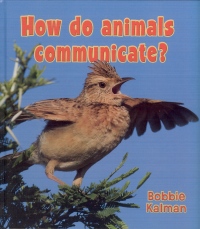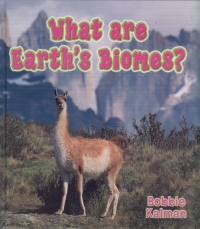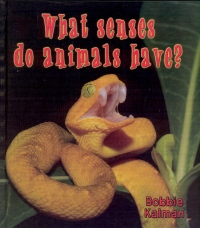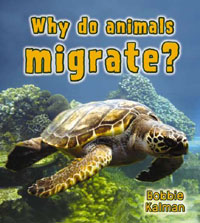| ________________
CM . . .
. Volume XVII Number 1. . . .September 3, 2010 
 |
How Do Animals Communicate? (Big Science Ideas).
Bobbie Kalman.
St. Catharines, ON: Crabtree, 2009.
32 pp., pbk. & hc., $9.95 (pbk.), $20.76 (hc.).
ISBN 978-0-7787-3302-7 (pbk.), ISBN 978-0-7787-3282-2 (hc.).
Subject Heading:
Animal communications-Juvenile literature.
Grades 2-4 / Ages 7-9.
Review by Suzanne Pierson.
***½ /4
|
| |
|
 |
What Are Earth's Biomes? (Big Science Ideas).
Bobbie Kalman.
St. Catharines, ON: Crabtree, 2009.
32 pp., pbk. & hc., $9.95 (pbk.), $20.76 (hc.).
ISBN 978-0-7787-3304-1 (pbk.), ISBN 978-0-7787-3284-6 (hc.).
Subject Heading:
Biotic communities-Juvenile literature.
Grades 2-4 / Ages 7-9.
Review by Suzanne Pierson.
***½ /4
|
| |
|
 |
What Senses Do Animals Have? (Big Science Ideas).
Bobbie Kalman.
St. Catharines, ON: Crabtree, 2009.
32 pp., pbk. & hc., $9.95 (pbk.), $20.76 (hc.).
ISBN 978-0-7787-3305-8 (pbk.), ISBN 978-0-7787-3285-3 (hc.).
Subject Heading:
Senses and sensation-Juvenile literature.
Grades 2-4 / Ages 7-9.
Review by Suzanne Pierson.
***½ /4
|
| |
|
 |
Why Do Animals Migrate? (Big Science Ideas).
Bobbie Kalman.
St. Catharines, ON: Crabtree, 2009.
32 pp., pbk. & hc., $9.95 (pbk.), $20.76 (hc.).
ISBN 978-0-7787-3303-4 (pbk.), ISBN 978-0-7787-3283-9 (hc.).
Subject Heading:
Animal migration-Juvenile literature.
Grades 2-4 / Ages 7-9.
Review by Suzanne Pierson.
***½ /4
|
| |
|

excerpt:
Do animals communicate?
Just like people, animals also need to share information. They communicate where to find food and warn one another of danger. They also use communication to attract mates. (From How Do Animals Communicate?)
The latest additions to the "Big Science Ideas" series continue the good quality of the earlier books in the series. Well-written text is beautifully supported by many colourful photographs and other illustrations. Young readers will benefit from the limited quantity of text compared to photos. Concepts, such as ecosystems, food chains, biomes and migration, are simply explained by words and pictures. Questions are used frequently to encourage young readers to engage with the information and to consolidate their understanding of the information being presented.
Each book includes a table of contents, a simple glossary and an index. One weakness of the series is the decision to not include every word that is highlighted in bold in the glossary at the back of each book. Some of the words are explained in the text and not included in the glossary.
"Note: Some boldfaced words are defined where they appear in the book." The use of bold font as an indicator that an explanation for the word will be found in the glossary is a fairly standard feature in nonfiction. Beginning researchers will take longer to recognize and use this feature since it is not consistently applied throughout the books.
In most cases, the clarity of the text and photos to illustrate the content overcomes any shortcomings about the use of boldface. The one exception that I noted to this is in What Senses Do Animals Have? The explanation of why the eyes of some animals appear to glow in the dark contains bold face text that is not explained in the glossary. Unfortunately, the explanation in the body of the text uses both singular and plural Latin terms which are sure to confuse young readers.
Shiny eyes
Some animals have a tapetum lucidum layer at the back of their eyes. The tapetum helps them see better at night. It reflects light and makes the eyes of animals appear to glow in the dark. Dogs, cats, foxes, lemurs, raccoons, and some fish and birds have tapeta.
Because many children this age love collecting long tongue-twister names, I don't object to the use of the correct scientific term. However, using tapetum lucidum layer, tapetum, and tapeta in the same paragraph is unnecessarily confusing.
Three of the four books in the series "Big Science Ideas" focus on animals' characteristics (communication, senses, and migration). The fourth book identifies and examines the Earth's biome regions.
How Do Animals Communicate? begins with an explanation of the concept of communication. The use of body language to communicate feelings is explained with a few lines of text accompanied by colourful photographs. The paragraph ends with a question which requires readers to interact with the content. "What are these children communicating through their body language?" This device of asking questions about the content is used several times, encouraging the reader to apply their understanding of the text to the pictures.
What are Earth's Biomes? complements the other three books in the series by describing the different biomes around the world. This is the only book of the four in this group that describes both living and non-living things, but the pictures are predominately of animals in each of the biomes. A two-page spread near the beginning of the book identifies each of the six main biomes: forest, desert, grassland, tundra, marine, and fresh water. Included with a photo of an animal in each biome is a caption which describes the biome and identifies the pages in the book which deal with that biome.
Deserts are dry biomes. Some deserts are very hot and sandy. Other deserts are not as dry or hot. See deserts on pages 18-21.
What Senses Do Animals Have?, like others in the series, includes many photos to illustrate the information. Pages 12-13 feature a quiz: "Whose eyes are these?" with amazing close-ups of eyes with clues and answers. Pages 30-31 feature another quiz: "Which sense is it?" that reviews the information presented in the book.
This butterfly is using its antennae, feet, and eyes. What senses are in these body parts? Which butterfly sense do we not have?
Why Do Animals Migrate? again uses amazing photographs beautifully laid out on the page with limited text to explain the reasons why animals migrate and the challenges that they have to overcome to be successful. Birds, caribou, elephants, whales, alligators, and sea turtles are some of the animals included in this book.
This series has many things to recommend it. The text layout, photographs and illustrations are all colourful and attention grabbing. Whether purchased separately or as a series, these books should be very popular with your beginning researchers.
Highly Recommended.
Suzanne Pierson, a retired teacher-librarian, is currently instructing librarianship courses at Queen's University in Kingston, ON.

To comment
on this title or this review, send mail to cm@umanitoba.ca.
Copyright © the Manitoba Library Association. Reproduction for personal
use is permitted only if this copyright notice is maintained. Any
other reproduction is prohibited without permission.
NEXT REVIEW |
TABLE OF CONTENTS FOR THIS ISSUE
- September 3, 2010.
AUTHORS |
TITLES |
MEDIA REVIEWS |
PROFILES |
BACK ISSUES |
SEARCH |
CMARCHIVE |
HOME |



